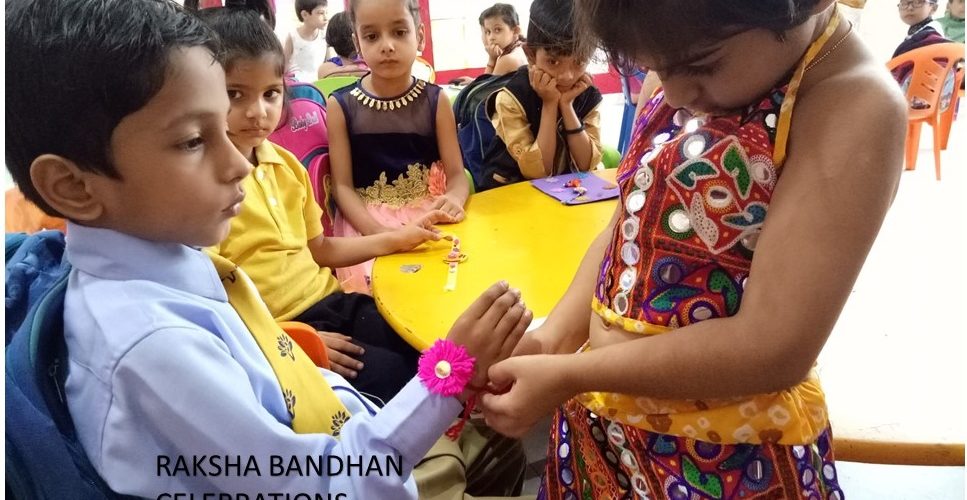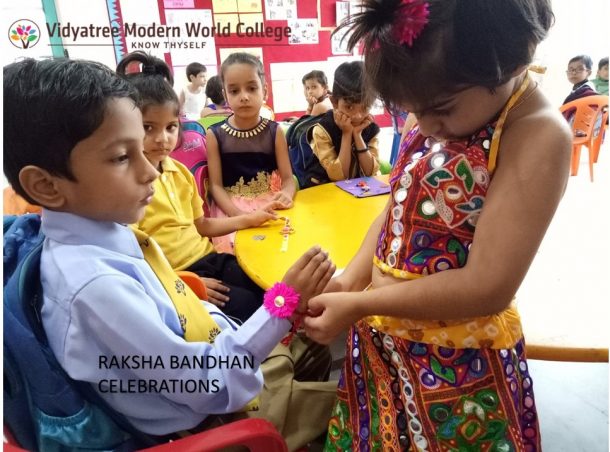Rakshabandhan

A festival of love and bonding - Rakshabandhan
India is a land of rich cultural heritage. In today’s contemporary world we are somehow losing the essence of our traditions and values. Therefore it is very important to inculcate these values in young children so that they are aware of their country’s traditions and learn to appreciate them.
We at Modern school, always make it a point to educate our children the relevance of different cultures and traditions, while discussing with them the different stories behind various festivals that we celebrate as Indians.

Why do we celebrate Rakshabandhan?
There are many stories in the Indian history that have a mention of this festival each with similar morals but different contexts. Here’s a compilation of the most renowned stories behind the grand festival of Rakhi.
Krishna and Draupadi
The most popular story in Indian mythology is that of Lord Krishna and Draupadi, ‘The wife of the five Pandavas’. The story goes on Makar Sankranti, Krishna cut his little finger when handling sugarcane. His Queen, Rukmini immediately sent an official to get bandages. Meanwhile Draupadi, who was watching the entire incident, cut off a little bit of her Saree and tied his finger with it to stop the bleeding. In return, Krishna promised to help her out when required. That is the story behind the help Krishna provides during the unceremonious disrobing of Draupadi, Krishna came and made her saree never ending, saving her the embarrassment by giving her protection when she needed it the most.
Rani Karnavati and Emperor Humayun
Another famous version of the history of Rakhi is of Rani Karnavati and Emperor Humayun.After the death of her husband Rana Sanga, Rani Karnavati ruled in the name of her elder son Vikramjeet. Bahadur Shah of Gujarat attacked Mewar for the second time. He had defeated Vikramjeet earlier. The Queen began looking for support from other kingdoms. She also wrote to Humayun for help. She sent him a rakhi and sought protection.The Mughal emperor was in the middle of another military campaign when he received the call for help. Abandoning it, he turned his attention to Mewar.Unfortunately, he never made it on time as the Rajput army was defeated in Chittoor. But the queen had already set herself on fire to avoid the indignity of falling in the hands of Bahadur Shah. Shah, however, could not go any further and had to turn away from Chittoor as Mughal military reinforcements arrived soon after. Humayun then restored the kingdom to Karnavati’s son, Vikramjeet.
Yama and the Yamuna
According to another legend, the ritual of Raksha Bandhan was followed by Yama, the Lord of Death and Yamuna, the river that flows in India. The story goes that when Yamuna tied a rakhi to Yama, the lord of death granted her immortality. And so moved he was by the gesture, he is said to have declared that any brother who has tied a Rakhi and offered to protect his sister would also become immortal.
The Birth of Santoshi Maa
On an auspicious day, Lord Ganesha’s sister Mansa visits him to tie him a rakhi. On seeing this, Ganesha’s sons begin insisting on having a sister. Giving in to their demands, Ganesha creates goddess Santoshi from the divine flames that are said to have emerged from his consorts Riddhi and Siddhi.
Goddess Laxmi and King Bali
As part of a promise, Lord Vishnu had been protecting his devotee and the demon King Bali, disguising himself as his doorman. Back in Vaikunth, the abode of Vishnu, his consort Laxmi has been missing him. Disguising herself as a woman seeking a shelter to live in since her husband has been away, she approaches Bali. The generous king opens the doors of his palaces for the lady. As Laxmi, the goddess of wealth and prosperity enters the household, Bali begins to prosper. On the full moon day of the holy month of Shravana, Laxmi ties a thread of coloured cotton on Bali’s wrist and wishes for protection and happiness. Bali asks her what she desires and promises to fulfil it. Laxmi simply points to the gatekeeper who now reveals his real identity. The goddess follows suit. Bali keeps his promise as he requests Vishnu to return to his home with his consort. In return, Vishnu promises to return and be with Bali for four months of each year.
